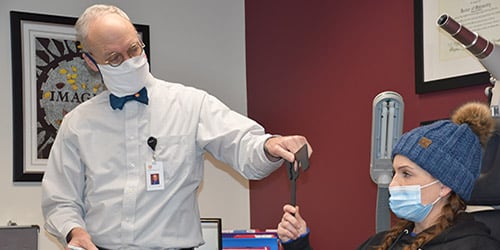From Dr. John Metzger, OD
The first thing that comes to mind about kids’ eyes is normally, “Do they need glasses for school?” or, “Should they be wearing sports glasses for protection?” Yes… very important.
As we think about August being Children’s Eye Health and Safety Month by the American Academy of Ophthalmology, here are two additional subjects to consider that are equally important, but perhaps a bit under the radar.
First, let’s talk about Myopia Control. Myopia = nearsightedness = “sees the book (near) just fine but can’t see the board at school (far).” This is important for eye health because Myopia can confer a higher chance of getting glaucoma, retinal detachment, and cataracts; not to mention saddling folks with unwanted eye wear. Approximately 50% of Americans deal with Myopia (estimates vary quite a bit) and genetics and environment are influential factors. Historically there has not been much to do about onset and control, but in recent years this has been a hot spot of study and solutions-development for true control of this condition.
Three modes of Myopia treatment have emerged as helpful in slowing the process and improving the outcome:
- First is a very weak concentration of atropine eye drops used at bedtime.
- Second, new and vastly improved soft contact lenses worn during the day.
- Third, gas perm contact lenses worn overnight to gently reshape the eye surface so that most patients go all the next day or even two days without another overnight treatment.
The two contact lens modes do not just compensate for the Myopia as standard contact lenses do, they actually treat the process to reduce or slow the myopia.
After Myopia Control, the second off-the-radar eye health treatment for children is Vision Therapy. Not just the “lazy eye” kind of therapy, but therapy for slow readers, slow learners, concussion sufferers (and for adults, stroke patients).
For these youth, we work on building eye coordination, eye tracking, focusing, visual information processing and eye-hand/eye-body control. The therapy is not aimed at building strong eye muscles (hardware), but it is aimed at developing better brain control (software). Goals include increased flexibility, stamina, accuracy and speed in physical eye skills as well as visual thinking skills. Vison therapy is concerned with clear vision too, but for near as well as for non-myopic far vision and for comfortable vision.
So, to summarize, recent developments have added additions to standard eye health concerns and remedial tools. It’s great to see kids reading who weren’t readers before, get done with homework quicker and with less eye fatigue and rely less on glasses for good vision.
Learn more about Alphapointe’s Low Vision Clinic and KC Vision Performance.

